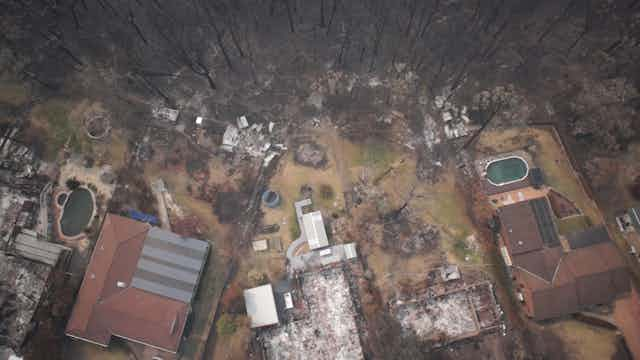When tragedies such as the NSW bushfires strike it might feel thoughtless and insensitive to talk about climate change. But history proves there are three reasons that disasters are precisely the time to talk about preparing and adapting to extreme events.
Is climate change to blame for extreme weather?
It’s almost impossible to attribute a disaster to climate change, mostly because with climate change we are talking about averages. Extreme events such as bushfires, heatwaves and floods occur infrequently, making up the “tail ends” of a frequency distribution graph (see below).

As you can see from the graph, we can expect the risk of extreme events to increase thanks to shifting average conditions. This is partly a function of the increased frequency of extreme events.
Even if we make good inroads into reducing greenhouse gas emissions, climate change is still likely to be the most disastrous of all extreme events we have faced.
In many ways though it actually doesn’t matter if we can build a clear case that climate change is responsible for extreme events, because we still have much to adapt to in Australia’s naturally variable and sometimes dangerous climate even before we consider the role of climate change.
While Australians are well aware of the risks of the bushfire season, cyclone season and storm season, the truth is we still face loss and tragedy with each and every event – loss of life, loss of property, loss of business, loss of lifestyle. And while Australians have a great spirit of mateship and sense of sympathy for victims of disasters, we all shoulder an enormous burden from disasters.
So I would argue there are at least three very good reasons we should be talking about adaptation (at the very least) and planning for increasing climate change impacts when disasters like the NSW bushfires hit. They are drawn from consideration of a number of historical extreme events and the adaptation actions that came out of them.
Emotion drives change
First, are the emotive drivers of policy change. There is always going to be “politicising” of disasters and tragedies (such as the asylum seeker debate). The idea that someone’s suffering or loss can, if nothing else, prompt change that might prevent another from a similar loss is tragically a common pathway for policy or legislative change.
Consider eponymous laws in Australia such as Queensland’s “Jet’s Law” following the death of a baby in a car accident. We have recently considered many historical extreme events, and seen that in many cases it is the pure horror and unacceptability of a disaster that drives policy change.
If we don’t act when the greatest public horror and desire never to experience the same scale of loss is so keen in our minds (and at the forefront of the media reporting cycle) then we will never bring about changes needed to address infrequent but disastrous events.
Economic cost
Second, is the economic burden (not to mention emotional and physical stress) that is placed on Australia.
Consider the summer of 2010-2011 – an exceptionally disastrous summer for Australia. In that summer alone, Australia faced the potential of a major locust infestation, bushfires in the Perth Hills, heatwaves in Sydney, major flooding in Queensland and Victoria and the crossing of Tropical Cyclone Yasi in north Queensland.
Professor David Karoly at University of Melbourne and I totalled the reported cost of these events and came up with A$12 billion in government expenditure and almost A$4.5 billion in insurance claims – a staggering A$16.5 billion in cost.
While the personal toll for people living in affected areas is unimaginable, and in many cases still ongoing, a simple division by the number of Australian households (8.18 million in 2011) suggests that the cost to every household was in the order of $2000.
Acknowledging that not all of this comes out of our hip-pockets, the indirect costs through taxes, insurance premiums and the costs of goods and services are likely to be significant.
It’s a cost that is going to be recurrent and good science and logic tells us that we should be expecting this to be a regular and increasing cost. But there is equally good evidence and logic that tells us that by planning and adapting now we can reduce that cost burden.
Battling the Aussie battler
The third is to ensure that “stoicism” is not mistaken for building resilience. Through a review of natural disaster case studies from across the world, it was almost universally consistent that many victims of those tragedies were under prepared for extreme events, even those consistent with existing climate patterns.
In many cases however, it was the actions after the event that were most significant in building communities that were prepared for future events - adaptation to an existing or potential risk.
Rather than shrugging our shoulders and accepting extreme events as part of life in Australia it’s time to consider if we can do better. There is already some movement in this direction. For example in Queensland, the government has announced policies of assessing risk and investing in “disaster-proof” infrastructure following the budgetary burden of several disastrous summers.
Following disaster, the urge to return to normal as quickly as possible is completely understandable, but we need to take the opportunity to address some tough questions about what risk and cost we are willing to accept and be prepared to make change.
Discussions should include deciding where it is reasonable for houses to be built, housing construction standards and emergency responses. The conversation needs to include a serious and significant commitment to financial and social investment now to reduce future risks. This would amount to genuinely building resilience.

